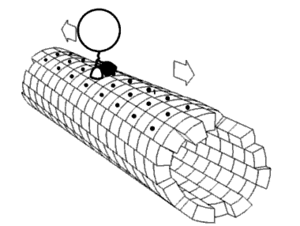 |
| Fig. 1 "Get your motor running" |
"In molecular biology, RNA polymerase (abbreviated RNAP or RNApol), or more specifically DNA-directed/dependent RNA polymerase (DdRP), is an enzyme that synthesizes RNA from a DNA template."
(RNA polymerase, emphasis added). The "-ase" family of goo is plastered over the "enzyme" layer of goo in order to make sure the cracks don't show so much:
"The suffix "-ase" is used to signify an enzyme. In enzyme naming, an enzyme is denoted by adding -ase to the end of the name of the substrate on which the enzyme acts. It is also used to identify a particular class of enzymes that catalyze a specific type of reaction."
(Biology Prefixes and Suffixes: -ase). Not that enzymes are not important, its just that the word enzyme does not connote a machine nature:
"Helicases are a class of enzymes thought to be vital to all organisms. Their main function is to unpack an organism's genetic material. Helicases are motor proteins that move directionally along a nucleic acid phosphodiester backbone, separating two hybridized nucleic acid strands (hence helic- + -ase), using energy from ATP hydrolysis. There are many helicases, representing the great variety of processes in which strand separation must be catalyzed. Approximately 1% of eukaryotic genes code for helicases.
 |
| Fig. 2 It is all atomic |
The human genome codes for 95 non-redundant helicases: 64 RNA helicases and 31 DNA helicases. Many cellular processes, such as DNA replication, transcription, translation, recombination, DNA repair, and ribosome biogenesis involve the separation of nucleic acid strands that necessitates the use of helicases. Some specialized helicases are also involved in sensing of viral nucleic acids during infection and fulfill a immunological function."(Helicase). "As of 2020, the smallest atomically precise molecular machine has a rotor that consists of four atoms." (Synthetic molecular motor) ... "which consists of a single acetylene (C2H2) rotor anchored to a chiral atomic cluster provided by a PdGa(111) surface that acts as a stator." (Molecular motor crossing the frontier of classical to quantum tunneling motion).
Practically, then, all "biochemical reactions" clearly are indicated to be mechanical, even though the goo words used in biology cover that up:
"Practically all of the numerous and complex biochemical reactions that take place in animals, plants, and microorganisms are regulated by enzymes [molecular machinery]. These catalytic proteins are efficient and specific—that is, they accelerate the rate of one kind of chemical reaction of one type of compound, and they do so in a far more efficient manner than human-made catalysts."
(Enzymes). It's just that they plaster the "-ase" family of words over the enzyme family of words, etc., instead of cutting to the chase, which is:
"To tell this story, we’re focusing on proteins. These large molecules facilitate just about every chemical process in our bodies: They “read” the genetic code, they catalyze reactions, they act as the gatekeepers to our cells. Proteins are made up of chains of small molecules called amino acids. Knowing how these chains fold up to create a three-dimensional structure is crucial, because it’s the 3D shape of proteins that determines how they work.
To create an accurate 3D model of a protein, we need to know the arrangement in space of all of the atoms in all of the amino acids that make up that protein. We can’t see atoms because they’re smaller than the wavelength of visible light. To detect them, we need a different kind of wave — a wave with a shorter wavelength and one that can penetrate surfaces to show us not just the atoms on the outside but also the atoms within the protein."
(Structural biology: How proteins got their close-up, emphasis added). Remember that the atoms of the amino acids and codons were displayed along with their molecular formula in a recent Dredd Blog post's appendices (Appendix QB.7.1, Appendix QB.7.2, Appendix QB.7.3, Appendix QB.7.4, Appendix QB.7.5, Appendix QB.7.6, Appendix QB.7.7, Appendix QB.7.8).For today's post, I added a new one (Appendix QB.8.1) which involves Bdellovibrio bacteriovorus, a sequence studied in Berlin by, and mentioned in a paper by the person who banned me from a blog (The Ways of Bernays - 3).
If you will notice, the B. bacteriovorus looks like the human chromosome tables in the previous post linked to above.
The vastly different biology of humans compared to B. bacteriovorus, is not obvious, which supports the quote above ("we need to know the arrangement in space of all of the atoms") to really grasp what is happening where the rubber meets the road.
"A chemical reaction rearranges the constituent atoms of the reactants to create different substances as products."
(Chemical reaction, emphasis added). The molecular machines at work never comes to mind accurately when the goo words are bantered about but molecular dynamics are left out.
The graphics at Fig. 1 and Fig. 2 in action show us what is going on without mentioning the goo words.
In the next post of this series I will provide the graphics of "the arrangement in space of all of the atoms" now that the molecular formulas have been posted.
The next post in this series is here, the previous post in this series is here.
No comments:
Post a Comment